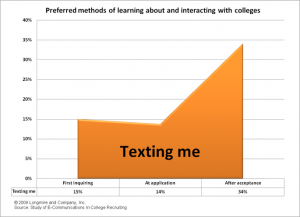 I’m running into a growing number of colleges that have abandoned traditional search mailings. Also, more colleges are opting to keep their reps at home, rather than sending them on the road during travel season. Why? The new age we’re in: stealth inquiries and cost-cutting.
I’m running into a growing number of colleges that have abandoned traditional search mailings. Also, more colleges are opting to keep their reps at home, rather than sending them on the road during travel season. Why? The new age we’re in: stealth inquiries and cost-cutting.
In recruiting years past, enrollment managers often had a sense of how committed their applicant pool was to their institution by the time the bulk of the applications had been submitted. They’d already had multiple points of contact with large numbers of prospective students between inquiry generation and application. There were opportunities to begin building bonds early in the cycle. Yields were predictable.
Measuring applicant pool commitment remains critically important because, as with anything in the business of enrollment management, measurement is the basis of control. Several years ago, Longmire and Company introduced the Applicant Commitment Index (ACI) – a number between one and four – that reflects how strongly a pool is devoted to an institution. The ACI score has proven to be instructive from two viewpoints: looking back and looking ahead.
Looking back, a high ACI score (bad) suggests that an institution’s marketing, brand or product is not strong enough to win the level of commitment students require to enroll. Looking ahead, a low ACI score (good) suggests that a high percentage of applicants have cemented their decision and enrollment is very likely. An ACI score is predictive of yield and enrollment – something that is very reassuring and helpful in this age of uncertainty.
Data that feeds the ACI comes from the students in the applicant pool. As part of Longmire and Company’s Yield Enhancement System program, over 100 data points are captured that influence the student’s college selection decision. Obtaining this information directly from students enables the calculation of the ACI but, more importantly, provides micro-level, real-time information about a student’s individual needs and preferences. With that information, a college can better match its communication (personal, print and electronic) and content to strengthen the student’s commitment. That’s the management after the measurement.



Successful recruiters know that developing a connection with a student can greatly increase their commitment to the college and improve the likelihood of enrollment. It’s clear from a recent Longmire and Company co-sponsored study that students will provide access to that connection. In the study, we found that 35% of the students said they don’t receive enough personal contact from colleges (see top chart).
In addition, as the recruiting cycle progressed, a higher percentage of students favored getting more telephone calls from colleges, even after having been accepted (middle chart) and, after acceptance, over one-third of students wanted to receive more text messages.
This and other data collected in the study suggest how important it is for an institution to deliver sustained and quality contact to the student after application. I can’t emphasize the word “quality” enough.
Our quantitative and qualitative research over the last three years has revealed a growing demand by students that the information they receive after application is personalized and highly relevant to their needs.
This is true whether they are stealth or not.
 October, also known as ” The Official Month for Campus Visits,” is upon us. If you are in the admissions biz you watch the Weather Channel 24/7 and pray that no rain, snow, sleet or other weather anomaly will dampen the academic, athletic and social activities you have worked so hard to prepare.
October, also known as ” The Official Month for Campus Visits,” is upon us. If you are in the admissions biz you watch the Weather Channel 24/7 and pray that no rain, snow, sleet or other weather anomaly will dampen the academic, athletic and social activities you have worked so hard to prepare.
